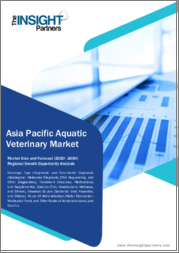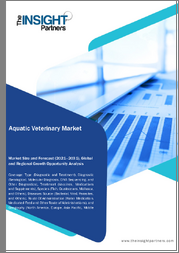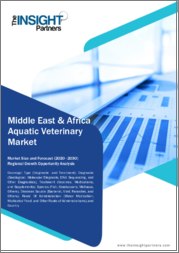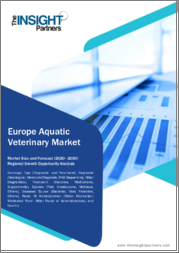
|
시장보고서
상품코드
1567783
유럽의 수산용 수의학 시장 예측(-2030년) : 지역 분석 - 유형별, 진단별, 치료별, 종별, 질환원별, 투여 경로별Europe Aquatic Veterinary Market Forecast to 2030 - Regional Analysis - by Type, Diagnostic, Treatment, Species, Diseases Source, and Route of Administration |
||||||
유럽의 수산용 수의학 시장은 2022년 4억 1,503만 달러로 평가되며, 2030년에는 5억 3,977만 달러에 달할 것으로 예상되며, 2022년부터 2030년까지 연평균 3.3%의 CAGR을 기록할 것으로 추정됩니다.
소비용 수생 동물 종에 대한 수요 급증으로 유럽의 수산용 수의학 시장을 견인
생선, 게, 홍합, 랍스터는 인간에게 식용으로 제공되는 수산동물 중 하나입니다. 해산물에 대한 수요 증가는 전 세계 어류 공급량 증가로 이어져 양식 산업을 촉진하고 있습니다. 생선은 비타민, 단백질, 지방산, 중요한 미량영양소, 미네랄 등 풍부한 영양소를 함유하고 있습니다. 생선은 오메가 3 지방산의 훌륭한 공급원으로 알려져 있습니다. 오메가 3 지방산은 심장마비 위험 감소, 소아 천식 및 우울증 예방, 뇌 건강 증진과 관련이 있는 것으로 연구되고 있습니다. 경제협력개발기구(OECD)에 따르면 2029년까지 전 세계 어류 생산량은 200톤에 달할 것으로 예상됩니다. 또한, 2029년까지 생산되는 생선의 거의 90%(즉, 180톤)가 인간이 식용으로 소비될 것으로 예상하고 있습니다. 게는 다량의 단백질, 영양소, 미네랄을 함유하고 있습니다. 게는 포화지방이 거의 없으며 오메가 3 불포화지방산인 도코사헥사엔산(DHA)과 에이코사펜타엔산(EPA)의 중요한 공급원입니다. 게의 영양학적 특성은 관절통과 고혈압 스트레스에 대한 효과에 대해서도 연구되고 있습니다. 게 섭취의 또 다른 이점으로는 뼈와 심장 건강 증진, 정서적 행복 등이 있습니다. 전 세계적으로 수산물 소비가 증가함에 따라 생산량도 증가하고 있습니다. 예를 들어, 러시아 연방 수산청에 따르면 러시아의 게 생산량은 2017년 8만 6,300톤에서 2020년에는 9만 3,300톤으로 증가할 것으로 예상됩니다. 수산물 소비가 증가함에 따라 고품질 생산물에 대한 수요가 증가하고 있으며, 이를 위해서는 적절한 영양소와 사료가 필요합니다. 이러한 영양소와 사료는 백신과 보충제 투여를 통해 제공됩니다. 따라서 수산물에 대한 수요 증가는 유럽의 수산용 수의학 시장을 주도하고 있습니다.
유럽의 수산용 수의학 시장 개요
독일의 유럽의 수산용 수의학 시장은 독일의 양식 산업의 지속적인 시장 개척으로 성장 가능성이 높습니다. 독일에는 다양한 양식업이 존재하며 주로 무지개송어, 잉어, 홍합 등의 양식 및 생산에 주력하고 있습니다. 독일 연방 통계청에 따르면, 2021년 독일에서는 2,200개 양식업체가 1만 8,300톤의 물고기를 생산했습니다. 같은 소식통에 따르면 홍합 생산량은 5.8% 증가하여 2021년에는 거의 1 만 4,300 톤에 달할 것으로 예상됩니다. 어란과 캐비어 생산량은 9톤에서 85톤으로 증가했습니다. 어류 생산량 증가와 생산 중 어류 건강에 대한 인식이 높아지면서 유럽의 수산용 수의학 시장의 성장을 촉진하는 요인으로 2022년 1월 독일 해양 양식 학회(Gesellschaft fur Marine Aquakultur mbH, GMA) 연구팀은 Lubeck의 IMTE(Fraunhofer Research Institution for Individualized and Cell-Based Medical Engineering)와 협력하여 이 분야의 전문성을 더욱 강화했습니다. 이를 통해 북독일 해양 경제를 강화하고 양식업의 생태적, 경제적 대차대조표를 개선하기 위한 혁신 기술을 촉진하는 한편, 이 조사소에 두 번째 거점을 제공하게 됩니다. 이러한 양식 및 어업 분야의 개척은 독일의 유럽의 수산용 수의학 시장을 강화할 것입니다.
유럽의 수산용 수의학 시장 수익 및 2030년까지 예측(금액)
유럽의 수산용 수의학 시장 세분화
유럽의 수산용 수의학 시장은 유형, 종, 질병 원인, 투여 경로, 국가별로 분류됩니다.
유형별로 유럽의 수산용 수의학 시장은 진단과 치료로 나뉘며, 2022년 시장 점유율은 치료 분야가 더 큽니다. 진단 부문은 혈청학, 분자학, DNA 염기서열 분석 및 기타 진단으로 세분화됩니다. 치료 분야는 백신, 의약품, 보충제로 세분화됩니다.
유형별로 유럽의 수산용 수의학 시장은 어류, 갑각류, 연체동물, 기타로 구분되며, 2022년에는 어류 부문이 가장 큰 시장 점유율을 차지했습니다.
질병의 원인에 따라 유럽의 수산용 수의학 시장은 세균, 바이러스, 기생충, 기타로 구분됩니다. 박테리아 부문이 2022년 가장 큰 시장 점유율을 차지했습니다.
투여 경로에 따라 유럽의 수산용 수의학 시장은 수액제, 약용 사료 및 기타 투여 경로로 나뉩니다. 수액 투여 부문은 2022년 가장 큰 시장 점유율을 차지했습니다.
국가별로 유럽의 수산용 수의학 시장은 영국, 독일, 프랑스, 스페인, 이탈리아, 기타 유럽으로 구분되며, 2022년 유럽의 수산용 수의학 시장 점유율은 독일이 독차지했습니다.
Aquatic Diagnostics Ltd, Ceva Polchem Pvt Ltd, Elanco Animal Health Inc, Esox Biologics Ltd, HIPRA SA, Merck KGaA, Phibro Animal Health Corp, Thermo Fisher Scientific Inc, Virbac SA, Zoetis Inc 등이 유럽의 수산용 수의학 시장에서 활동하는 주요 기업입니다.
목차
제1장 소개
제2장 주요 요약
- 주요 인사이트
제3장 조사 방법
- 조사 범위
- 2차 조사
- 1차 조사
제4장 유럽의 수산용 수의학 시장 : 주요 시장 역학
- 시장 성장 촉진요인
- 수산양식 산업 발전에 대한 정부 이니셔티브
- 수산용 수의학종 소비 수요 급증
- 시장 성장 억제요인
- 백신 승인에 관한 엄격한 규제
- 시장 기회
- 신규 어류 백신 개발
- 향후 동향
- 어류 백신의 기술적 진보
- 성장 촉진요인과 억제요인의 영향
제5장 수산용 수의학 시장 : 유럽 시장 분석
- 유럽의 수산용 수의학 시장 매출, 2020-2030년
제6장 유럽의 수산용 수의학 시장 분석 : 유형별
- 진단
- 치료
제7장 유럽의 수산용 수의학 시장 분석 : 종별
- 어류
- 갑각류
- 연체동물
- 기타
제8장 유럽의 수산용 수의학 시장 분석 : 질환원별
- 세균성
- 바이러스
- 기생충
- 기타
제9장 유럽의 수산용 수의학 시장 분석 : 투여 경로별
- 물약
- 약용 사료
- 기타 투여 경로
제10장 유럽의 수산용 수의학 시장 : 국가별 분석
- 유럽
- 영국
- 독일
- 프랑스
- 스페인
- 이탈리아
- 기타 유럽
- 기타 지역
제11장 업계 상황
- 수산용 수의학 시장의 성장 전략
- 유기적 성장 전략
- 무기적 성장 전략
제12장 기업 개요
- Esox Biologics Ltd
- Zoetis Inc
- Merck KGaA
- HIPRA SA
- Ceva Polchem Pvt Ltd
- Virbac SA
- Elanco Animal Health Inc
- Phibro Animal Health Corp
- Aquatic Diagnostics Ltd
- Thermo Fisher Scientific Inc
제13장 부록
ksm 24.10.24The Europe aquatic veterinary market was valued at US$ 415.03 million in 2022 and is expected to reach US$ 539.77 million by 2030; it is estimated to register a CAGR of 3.3% from 2022 to 2030.
Surging Demand for Aquatic Animal Species for Consumption Drives Europe Aquatic Veterinary Market
Fishes, crabs, mussels, and lobsters are among the aquatic animals that are used for human consumption. The increasing demand for seafood results in a greater fish supply worldwide, which, in turn, boosts the aquaculture industry. Fishes have a rich nutritional profile, including vitamins, proteins, fatty acids, vital micronutrients, and minerals. They are known as an excellent source of omega-3 fatty acids. Omrega-3 fatty acids have been studied for their association with the reduction of risk of heart attacks, prevention of childhood asthma and depression, and improvement of brain health. As per the Organization for Economic Cooperation and Development (OECD), global fish production volume is expected to reach 200 metric ton by 2029. Further, nearly 90% of the fish produced (i.e., ~180 metric ton) would be consumed as food by humans by 2029. Significant amounts of proteins, nutrients, and minerals are found in crabs. They have little saturated fat content and are an important source of omega-3 unsaturated fats-docosahexaenoic acid (DHA) and Eicosapentaenoic Acid (EPA). The nutrient profile of crabs has also been studied for its effects against joint pain and high vascular stress. Other benefits of crab consumption include bone and heart health improvements, and emotional well-being. The globally increasing consumption of aquatic animals is subsequently leading to an upsurge in production. For instance, as per the Federal Agency for Fishery, the production volume of crab in Russia increased from 86.3 thousand metric tons in 2017 to 93.3 thousand metric tons in 2020. With the increasing consumption of seafood, there is a growing need for high-quality produce, which requires proper nutrients and feeds. These nutrients and feeds can be provided by the administration of vaccines and supplements. Therefore, the growing demand for seafood products drives the Europe aquatic veterinary market.
Europe Aquatic Veterinary Market Overview
The Europe aquatic veterinary market in Germany is likely to grow due to ongoing developments in the country's aquaculture and fishery industry. The country has the presence of various aquaculture businesses, majorly focusing on culturing and producing rainbow trout, common carp, mussels, etc. According to the Federal Statistical Office, ~18,300 metric ton of fishes were produced in Germany in 2021 by 2,200 aquaculture businesses. As per the same source, the production of mussels rose by 5.8% to reach nearly 14,300 metric ton in 2021. The production of roe and caviar increased from 9 metric ton to ~85 metric ton. The increase in the production of fish and growing awareness about the health of the fish during production are factors fueling the growth of the Europe aquatic veterinary market. In January 2022, a research team at the German Society for Marine Aquaculture (Gesellschaft fur Marine Aquakultur mbH, GMA) collaborated with the Fraunhofer Research Institution for Individualized and Cell-Based Medical Engineering IMTE in Lubeck to further consolidate the institution's expertise in this area. This provides the research institute with a second site, alongside strengthening the maritime economy in northern Germany and promoting innovative technologies to improve the ecological and economic balance sheet of aquaculture. Such development in the aquaculture and fisheries sector bolsters the Europe aquatic veterinary market in Germany.
Europe Aquatic Veterinary Market Revenue and Forecast to 2030 (US$ Million)
Europe Aquatic Veterinary Market Segmentation
The Europe aquatic veterinary market is categorized into type, species, diseases source, route of administration, and country.
Based on type, the Europe aquatic veterinary market is bifurcated diagnostic and treatment. The treatment segment held a larger market share in 2022. The diagnostic segment is further sub segmented into serological, molecular, DNA sequencing, and other diagnostics. The treatment segment is further sub segmented into vaccines, medications, and supplements.
By species, the Europe aquatic veterinary market is segmented into fish, crustaceans, mollusca, and others. The fish segment held the largest market share in 2022.
Based on diseases source, the Europe aquatic veterinary market is segmented into bacterial, viral, parasites, and others. The bacterial segment held the largest market share in 2022.
In terms of route of administration, the Europe aquatic veterinary market is segmented into water medication, medicated feed, and other route of administrations. The water medication segment held the largest market share in 2022.
By country, the Europe aquatic veterinary market is segmented into the UK, Germany, France, Spain, Italy, and the Rest of Europe. Germany dominated the Europe aquatic veterinary market share in 2022.
Aquatic Diagnostics Ltd, Ceva Polchem Pvt Ltd, Elanco Animal Health Inc, Esox Biologics Ltd, HIPRA SA, Merck KGaA, Phibro Animal Health Corp, Thermo Fisher Scientific Inc, Virbac SA, and Zoetis Inc are some of the leading companies operating in the Europe aquatic veterinary market.
Table Of Contents
1. Introduction
- 1.1 The Insight Partners Research Report Guidance
- 1.2 Market Segmentation
2. Executive Summary
- 2.1 Key Insights
3. Research Methodology
- 3.1 Coverage
- 3.2 Secondary Research
- 3.3 Primary Research
4. Europe Aquatic Veterinary Market - Key Market Dynamics
- 4.1 Market Drivers
- 4.1.1 Government Initiatives to Develop Aquaculture Industry
- 4.1.2 Surging Demand for Aquatic Animal Species for Consumption
- 4.2 Market Restraints
- 4.2.1 Stringent Regulations for Vaccine Approvals
- 4.3 Market Opportunities
- 4.3.1 Development of Novel Fish Vaccines
- 4.4 Future Trends
- 4.4.1 Technological Advancements in Fish Vaccines
- 4.5 Impact of Drivers and Restraints:
5. Aquatic Veterinary Market - Europe Market Analysis
- 5.1 Europe Aquatic Veterinary Market Revenue (US$ Million), 2020-2030
6. Europe Aquatic Veterinary Market Analysis - by Type
- 6.1 Diagnostic
- 6.1.1 Overview
- 6.1.2 Diagnostic: Europe Aquatic Veterinary Market - Revenue and Forecast to 2030 (US$ Million)
- 6.2 Treatment
- 6.2.1 Overview
- 6.2.2 Treatment: Europe Aquatic Veterinary Market - Revenue and Forecast to 2030 (US$ Million)
7. Europe Aquatic Veterinary Market Analysis - by Species
- 7.1 Fish
- 7.1.1 Overview
- 7.1.2 Fish: Europe Aquatic Veterinary Market - Revenue and Forecast to 2030 (US$ Million)
- 7.2 Crustaceans
- 7.2.1 Overview
- 7.2.2 Crustaceans: Europe Aquatic Veterinary Market - Revenue and Forecast to 2030 (US$ Million)
- 7.3 Mollusca
- 7.3.1 Overview
- 7.3.2 Mollusca: Europe Aquatic Veterinary Market - Revenue and Forecast to 2030 (US$ Million)
- 7.4 Others
- 7.4.1 Overview
- 7.4.2 Others: Europe Aquatic Veterinary Market - Revenue and Forecast to 2030 (US$ Million)
8. Europe Aquatic Veterinary Market Analysis - by Diseases Source
- 8.1 Bacterial
- 8.1.1 Overview
- 8.1.2 Bacterial: Europe Aquatic Veterinary Market - Revenue and Forecast to 2030 (US$ Million)
- 8.2 Viral
- 8.2.1 Overview
- 8.2.2 Viral: Europe Aquatic Veterinary Market - Revenue and Forecast to 2030 (US$ Million)
- 8.3 Parasites
- 8.3.1 Overview
- 8.3.2 Parasites: Europe Aquatic Veterinary Market - Revenue and Forecast to 2030 (US$ Million)
- 8.4 Others
- 8.4.1 Overview
- 8.4.2 Others: Europe Aquatic Veterinary Market - Revenue and Forecast to 2030 (US$ Million)
9. Europe Aquatic Veterinary Market Analysis - by Route of Administration
- 9.1 Water Medication
- 9.1.1 Overview
- 9.1.2 Water Medication: Europe Aquatic Veterinary Market - Revenue and Forecast to 2030 (US$ Million)
- 9.2 Medicated Feed
- 9.2.1 Overview
- 9.2.2 Medicated Feed: Europe Aquatic Veterinary Market - Revenue and Forecast to 2030 (US$ Million)
- 9.3 Other Route of Administrations
- 9.3.1 Overview
- 9.3.2 Other Route of Administrations: Europe Aquatic Veterinary Market - Revenue and Forecast to 2030 (US$ Million)
10. Europe Aquatic Veterinary Market - Country Analysis
- 10.1 Europe
- 10.1.1 Europe Aquatic Veterinary Market Breakdown, by Key Countries, 2022 and 2030 (%)
- 10.1.1.1 Europe Aquatic Veterinary Market - Revenue and Forecast Analysis - by Country
- 10.1.1.1 UK
- 10.1.1.2 UK: Europe Aquatic Veterinary Market - Revenue and Forecast to 2030 (US$ Million)
- 10.1.1.2.1 UK: Europe Aquatic Veterinary Market Breakdown, by Type
- 10.1.1.2.1.1 UK: Europe Aquatic Veterinary Market Breakdown, by Diagnostic
- 10.1.1.2.1.2 UK: Europe Aquatic Veterinary Market Breakdown, by Treatment
- 10.1.1.2.2 UK: Europe Aquatic Veterinary Market Breakdown, by Species
- 10.1.1.2.3 UK: Europe Aquatic Veterinary Market Breakdown, by Diseases Source
- 10.1.1.2.4 UK: Europe Aquatic Veterinary Market Breakdown, by Route of Administration
- 10.1.1.3 Germany
- 10.1.1.4 Germany: Europe Aquatic Veterinary Market - Revenue and Forecast to 2030 (US$ Million)
- 10.1.1.4.1 Germany: Europe Aquatic Veterinary Market Breakdown, by Type
- 10.1.1.4.1.1 Germany: Europe Aquatic Veterinary Market Breakdown, by Diagnostic
- 10.1.1.4.1.2 Germany: Europe Aquatic Veterinary Market Breakdown, by Treatment
- 10.1.1.4.2 Germany: Europe Aquatic Veterinary Market Breakdown, by Species
- 10.1.1.4.3 Germany: Europe Aquatic Veterinary Market Breakdown, by Diseases Source
- 10.1.1.4.4 Germany: Europe Aquatic Veterinary Market Breakdown, by Route of Administration
- 10.1.1.5 France
- 10.1.1.6 France: Europe Aquatic Veterinary Market - Revenue and Forecast to 2030 (US$ Million)
- 10.1.1.6.1 France: Europe Aquatic Veterinary Market Breakdown, by Type
- 10.1.1.6.1.1 France: Europe Aquatic Veterinary Market Breakdown, by Diagnostic
- 10.1.1.6.1.2 France: Europe Aquatic Veterinary Market Breakdown, by Treatment
- 10.1.1.6.2 France: Europe Aquatic Veterinary Market Breakdown, by Species
- 10.1.1.6.3 France: Europe Aquatic Veterinary Market Breakdown, by Diseases Source
- 10.1.1.6.4 France: Europe Aquatic Veterinary Market Breakdown, by Route of Administration
- 10.1.1.7 Spain
- 10.1.1.8 Spain: Europe Aquatic Veterinary Market - Revenue and Forecast to 2030 (US$ Million)
- 10.1.1.8.1 Spain: Europe Aquatic Veterinary Market Breakdown, by Type
- 10.1.1.8.1.1 Spain: Europe Aquatic Veterinary Market Breakdown, by Diagnostic
- 10.1.1.8.1.2 Spain: Europe Aquatic Veterinary Market Breakdown, by Treatment
- 10.1.1.8.2 Spain: Europe Aquatic Veterinary Market Breakdown, by Species
- 10.1.1.8.3 Spain: Europe Aquatic Veterinary Market Breakdown, by Diseases Source
- 10.1.1.8.4 Spain: Europe Aquatic Veterinary Market Breakdown, by Route of Administration
- 10.1.1.9 Italy
- 10.1.1.10 Italy: Europe Aquatic Veterinary Market - Revenue and Forecast to 2030 (US$ Million)
- 10.1.1.10.1 Italy: Europe Aquatic Veterinary Market Breakdown, by Type
- 10.1.1.10.1.1 Italy: Europe Aquatic Veterinary Market Breakdown, by Diagnostic
- 10.1.1.10.1.2 Italy: Europe Aquatic Veterinary Market Breakdown, by Treatment
- 10.1.1.10.2 Italy: Europe Aquatic Veterinary Market Breakdown, by Species
- 10.1.1.10.3 Italy: Europe Aquatic Veterinary Market Breakdown, by Diseases Source
- 10.1.1.10.4 Italy: Europe Aquatic Veterinary Market Breakdown, by Route of Administration
- 10.1.1.11 Rest of Europe
- 10.1.1.12 Rest of Europe Aquatic Veterinary Market - Revenue and Forecast to 2030 (US$ Million)
- 10.1.1.12.1 Rest of Europe Aquatic Veterinary Market Breakdown, by Type
- 10.1.1.12.1.1 Rest of Europe Aquatic Veterinary Market Breakdown, by Diagnostic
- 10.1.1.12.1.2 Rest of Europe Aquatic Veterinary Market Breakdown, by Treatment
- 10.1.1.12.2 Rest of Europe Aquatic Veterinary Market Breakdown, by Species
- 10.1.1.12.3 Rest of Europe Aquatic Veterinary Market Breakdown, by Diseases Source
- 10.1.1.12.4 Rest of Europe Aquatic Veterinary Market Breakdown, by Route of Administration
- 10.1.1 Europe Aquatic Veterinary Market Breakdown, by Key Countries, 2022 and 2030 (%)
11. Industry Landscape
- 11.1 Overview
- 11.2 Growth Strategies in Aquatic Veterinary Market
- 11.3 Organic Growth Strategies
- 11.3.1 Overview
- 11.4 Inorganic Growth Strategies
- 11.4.1 Overview
12. Company Profiles
- 12.1 Esox Biologics Ltd
- 12.1.1 Key Facts
- 12.1.2 Business Description
- 12.1.3 Products and Services
- 12.1.4 Financial Overview
- 12.1.5 SWOT Analysis
- 12.1.6 Key Developments
- 12.2 Zoetis Inc
- 12.2.1 Key Facts
- 12.2.2 Business Description
- 12.2.3 Products and Services
- 12.2.4 Financial Overview
- 12.2.5 SWOT Analysis
- 12.2.6 Key Developments
- 12.3 Merck KGaA
- 12.3.1 Key Facts
- 12.3.2 Business Description
- 12.3.3 Products and Services
- 12.3.4 Financial Overview
- 12.3.5 SWOT Analysis
- 12.3.6 Key Developments
- 12.4 HIPRA SA
- 12.4.1 Key Facts
- 12.4.2 Business Description
- 12.4.3 Products and Services
- 12.4.4 Financial Overview
- 12.4.5 SWOT Analysis
- 12.4.6 Key Developments
- 12.5 Ceva Polchem Pvt Ltd
- 12.5.1 Key Facts
- 12.5.2 Business Description
- 12.5.3 Products and Services
- 12.5.4 Financial Overview
- 12.5.5 SWOT Analysis
- 12.5.6 Key Developments
- 12.6 Virbac SA
- 12.6.1 Key Facts
- 12.6.2 Business Description
- 12.6.3 Products and Services
- 12.6.4 Financial Overview
- 12.6.5 SWOT Analysis
- 12.6.6 Key Developments
- 12.7 Elanco Animal Health Inc
- 12.7.1 Key Facts
- 12.7.2 Business Description
- 12.7.3 Products and Services
- 12.7.4 Financial Overview
- 12.7.5 SWOT Analysis
- 12.7.6 Key Developments
- 12.8 Phibro Animal Health Corp
- 12.8.1 Key Facts
- 12.8.2 Business Description
- 12.8.3 Products and Services
- 12.8.4 Financial Overview
- 12.8.5 SWOT Analysis
- 12.8.6 Key Developments
- 12.9 Aquatic Diagnostics Ltd
- 12.9.1 Key Facts
- 12.9.2 Business Description
- 12.9.3 Products and Services
- 12.9.4 Financial Overview
- 12.9.5 SWOT Analysis
- 12.9.6 Key Developments
- 12.10 Thermo Fisher Scientific Inc
- 12.10.1 Key Facts
- 12.10.2 Business Description
- 12.10.3 Products and Services
- 12.10.4 Financial Overview
- 12.10.5 SWOT Analysis
- 12.10.6 Key Developments
13. Appendix
- 13.1 About The Insight Partners
- 13.2 Glossary of Terms












